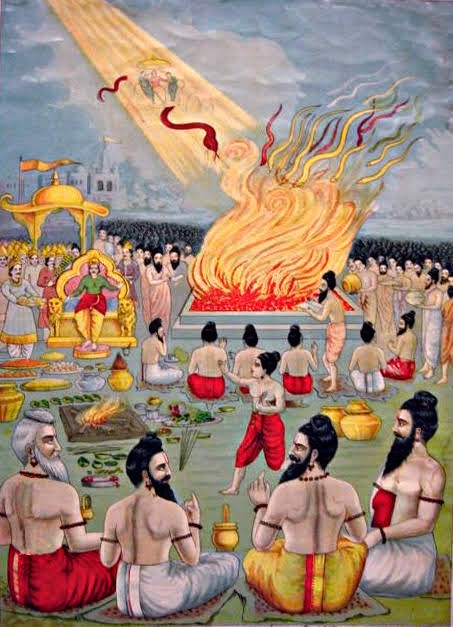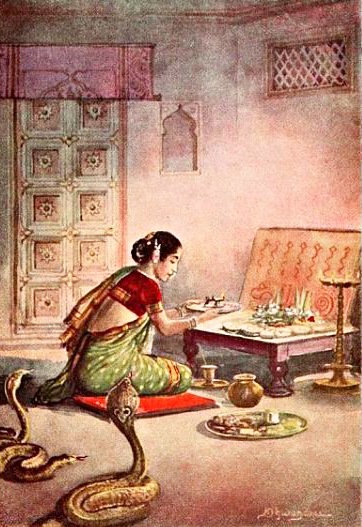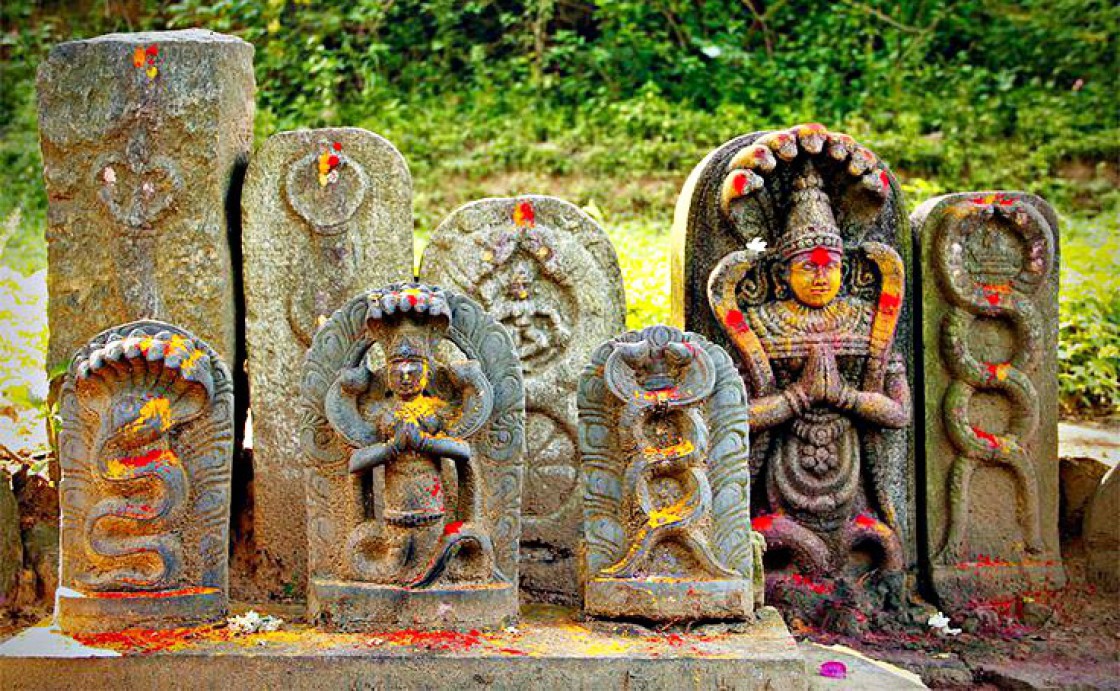The holy month of Shravan holds a strong significance for the devotees of Lord Shiva as it is completely dedicated to him, which we have already discussed in the previous article. Since we all know that snakes hold a vital place in Hinduism & are closely related to Lord Shiva; a special day is dedicated to worship the snakes.
Worshipping the nature has been a part of Hinduism since ancient times, but with the time, people are attracting more towards the western culture & forgetting the roots of our culture, because of which nowadays very few people believe in such worships. And rather protecting & worshipping the nature, people harm the nature by cutting trees, killing animals as a sport or using them as a meal. But as we always say that, Hindu is a way of living & not a religion, there are also reasons for worshipping snakes on this day too. Such festival increases the religious faith of a person & it also links the human to nature. This day is devoted to Snake God. The Snake God is offered special worship on this day. Snakes are considered as the incarnation of power & sun. As per ancient scriptures, Naag Panchami (नाग पंचमी) holds a great importance in the Indian culture. Many people admire the snake or Naag as their Kula Devata (ancestry God) (कुल-देवता).
Naag Panchami (नाग पंचमी) is a day on which the snakes are worshipped which is observed by Hindus, Jains & Buddhists throughout India & Nepal. This day is celebrated twice a month or sometimes once a month. According to the one who follows the Purnimanta (पूर्णिमान्तः) calendar (a month which ends on the full moon day), celebrate this day on the fifth day of the bright fortnight of the Shravan Month (श्रावणः शुक्लपक्षे पञ्चमी) while, according to the one who follows the Amavasyanta (अमावस्यान्तः) calendar (a month which ends on the no moon day), celebrate this day on the fifth day of the dark fortnight of the Shravan Month (श्रावणः कृष्णपक्षे पञ्चमी). The states like Madhya Pradesh, Maharashtra, etc. celebrated this day on the fifth day of the bright fortnight of the Shravan Month (श्रावणः शुक्लपक्षे पञ्चमी) & the states like, Karnataka, Rajasthan, Gujarat, etc. celebrate this day on the fifth day of the dark fortnight of the Shravan Month (श्रावणः कृष्णपक्षे पञ्चमी).

Significance of Naag Panchami (नाग पंचमी) –
According to the Vedas & Puranas, the origin of the Snakes is from sage Kashyap & his wife Kadru & according to the same source, Patal Lok is famous for the original place of serpents. In the Puranas, along with the description of Yakshas, Gandarvas & Kinnaras, description of serpents has also been given. According to the Scriptures like the Garuda Purana, Bhavishya Purana, Charaka Samhita, Sushruta Samhita, etc., mentioned various subjects related to snakes.
As we all know, Snake is the ornament of Lord Shiva & Lord Ganesha, the Sheshnaag is the bed of Lord Vishnu. The Kundalini Shakti which is awakened for the attainment of Yoga is called Sarpini. In this way other deities also wear snakes as their ornaments. Nag Devata has been accepted as a deity in Indian culture. In Hindu religion, nature’s creature, plant, movable & immovable things are considered as God. As it is stated in the scriptures that;
समं सर्वेषु भूतेषु तिष्ठन्तं परमेश्वरम्।
Meaning – The God resides eaqually in each & every creature.
Such thoughts teach humans to live our lives harmoniously along with all the creatures. It teaches us to live life with intimacy & kindness without harming any creatures. So, snakes are always worshipped & protected by Hindus.
Snake has been given much importance. The Snake Goddess Manasa Devi & Ashta Nag are worshipped on this day. It is also called as Manasa Devi Ashtanga Puja. In Punjab, it is known as Guga-Navami. Devotees also celebrate this day to remember Lord Krishna's victory over Kaliya Snake.
According to the Puranas, snakes have more powers than humans. Our nation has always been identified with farming, & snakes plays an important role. Rodents, like rats, spoil the crop by eating the grains, but as snakes eat the rats, they are proved to be helpful to the farmers. Perhaps to celebrate their friendship with farmers, snakes were being worshiped on this auspicious day.
The main reason of celebrating this day is that the snakes are a great threat to humans during these monsoon months. They usually come out of their holes as rainwater seeps in & while looking for shelter they might harm humans. However, this is why they are worshipped on this day & fed with milk.
According to the Dharma Sindhu & Nirnay Sindhu, Snake is associated with the Moon’s nodes known in Hindu astrology. The head of the snake is represented as Rahu ("Dragon's head") & its tail by Ketu ("Dragon's tail"). If in the horoscope chart of an individual all the seven major planets are combined between Rahu & Ketu in the reverse order (anticlockwise) it is known as Kaala Sarpa Dosha (Defect on life due to black snakes), which predicts bad luck & hardship in an individual's life. The remedy for this defect is also stated in the Puranas as well as in the Dharma Sindhu & Nirnay Sindhu that, the person bearing Kaala Sarpa Dosha in his/her horoscope has to worship Snake God on Naag Panchami. Also, one must offer silver snake in the temple of Lord Shiva & if one is not able to do so then, he/she must worship Lord Shiva & Snake God on this day. That person can also perform fast on this day to rectify the Kaala Sarpa Dosha. Various other remedial pujas are also performed on Nag Panchami to rectify this dosha & others too.
People who observe Naag Panchami religiously according to Hindu tradition, worship Nine serpents on this day. These nine serpents are;
अनन्तं वासुकिं शेषं पद्मनाभं च कम्बलम्।
शंखपालं धार्तराष्ट्रं तक्षकं कालियं तथा।
Meaning - Ananta, Vasuki, Shesha, Padmanabha & Kambala; Shankhapala, Dhritarashtra, Takshaka & also Kaliya.
Naag-Aradhana is performed in many parts of the world in many ways. In Bharat, Naagatanu, Naagatambila, Aaashleshabali, Naagamandala etc., are the types of Naga-Aradhana which are especially performed on this day. According to the Scriptures, performing Naag-Aradhana, one can solve the problems like insecurity, infertility, eyesight problem, skin diseases, etc., up to a great extent.
Spiritually speaking, Naag became prominent wherever people spent more time with eyes closed, & perceived something beyond the five senses. They recognized the significance of this dimension of evolutionary residue which remains within us, how we can activate that to evolve beyond the limitations of the senses. There are innumerable legends which represents a serpent across all cultures without exception. You can see the symbols in the forms of various artifacts all around the world, showing how snakes played an important part in the mystical journey of those tribes. There are serpent symbolisms in many places like; Russia, China, Africa, Egypt, Greece, South America, North America & of course, India.
Naag Panchami (नाग पंचमी) also represents Yoga. This day is very significant for those who want to know life beyond their physicality & beyond their five senses. This is not just about experiencing, realizing or liberation, in fact this is about knowing. Maybe not everyone wishes to know. Some people just want to be free, & they do not care to know. That is all right. But for those who want to know, this aspect of evolutionary reminder within you is very important. Whether you actually relate to the symbolism or not, you have to revitalize that dimension. If you want to know aspects beyond the five senses, your Adishesha has to begin to uncoil & move.

Historical account of Naag Panchami (नाग पंचमी) –
According to the Mahabharata, once the King Parikshit went for hunting in the forest. There, he sees a deer & shoots an arrow at the deer & the deer gets wounded. That deer tried to escape & hides into the bushes. While searching for the deer King Parikshit saw a sage sitting under a tree. The name of that sage was Shanak. Sage Shanak had a vow of staying silent (मौन व्रतम्) about which King Parikshit was unknown. So, King Parikshit asks him whether he saw a wounded deer or not, to this sage Shanak did not reply. Out of anger King Parikshit throws a dead snake on sage Shanak’s neck & went away in search of the deer.
On the other hand, the son of sage Shanak named Shrungi came to know about the behaviour of King Parikshit towards his father so he curses king Parikshit that the one who insulted my father will get bitten by the snake named Takshak within seven days & he will die. So, King Parikshit lives in a safe house where snakes cannot enter. But King Parikshit gets hungry & from a tree he takes a fruit, that fruit contained a bug. Snake Takshak was in the form of a bug, so Takshak took his original form & bites King Parikshit & he died.
The son of King Parikshita, Janamejeya came to know about this whole incident & so he took a vow of performing a sacrificial rite in which he will kill all the snakes including snake Takshak. So, once he invited many Brahmins & started performing a snake sacrifice which is known as Sarpa Satra Yagna, to revenge the death of his father King Pariskshit. Well-known brahmins were called & a sacrificial fireplace was being set up to eradicate all the snakes from the world. As planned, the recitation of mantras was so powerful that all the snakes were falling into the Yagna Kunda (sacrificial fireplace).
Brahmin priests found out after some time that the King of snakes Takshaka is not coming into the Yagna Kunda as he has gone into the refuge of Indra for protection. As a solution, they increased the pace of recitation of mantras which forced both Takshaka & Indra to fall into the fireplace. This situation frightened the other Gods & they requested Mansadevi to step in & handle the situation.
Later, Mansadevi sent her son Astika to request Janamejay to stop the sacrificial fireplace. Astika then went there & requested to stop the Yagna, which shifted to the heated argument & Astika explained the reason why Takshak killed Janmejay’s father along with the Scriptural knowledge. Janmejay got astonished with Astika’s knowledge & in return, he accepted his request to stop the Yagna.
That’s how Takshaka & his race’s life was spared. That day happened to be the fifth day of the dark fortnight in the month of Shravan & since then it is celebrated as it marks that their life was spared on this day.
Yet another story is connected to this festival is stated in the Shiva Puran. According to the legend the practice of feeding milk to the snakes dates back to Samudra-Manthan. In the quest of bringing Amrut Kalash (a pot of Ambrosia/ Nectar) by the Gods & Demons, a deadly poison Halahal erupted from the ocean, which had a power to wipeout the entire creation. To save the creation, Lord Shiva drank the poison which was stopped in his neck by Goddess Parvati. While drinking the poison, some droplets fell on earth, which was consumed by the snakes. Lord Shiva blessed them that as you all of you drank poison with me & contributed to the welfare of the world; I bless you that from today your worship will be mine.
Later, to calm the burning effect of the deadly poison, all the Gods & Demons offered milk & water to Lord Shiva & the snakes. So, not only on Naag Panchami, some devotees offer milk to the snakes in this entire month along with Lord Shiva, as snakes are dear to Lord Shiva.

Ritual ceremony of Naag Panchmi (नाग पंचमी) –
On Naag Panchami (नाग पंचमी), the idol of Snakes is worshipped with five Worshipping Practices (पञ्च उपचारः). Lord Shiva is also worshipped along with the snake idols. Idols of the Snake are eighter made up of silver, stone, wood or a painting of snakes. After taking a holy bath, devotees visit temples & snake pits in temples to worship the snakes. By praying Snake God, one is freed from the fear of snakes & serpents. It also protects us from all the evils. Devotees also perform the Naag Puja in temples to get relief from Naag Dosha or Kaal Sarpa Dosha.
People pray Snakes to keep them & their loved ones guarded from the snakes as during this time of the year snakes come out of their hideouts in search of dry places. Although venomous, snakes are considered peaceful & harmless beings, but they get aggressive only when they are attacked by humans. According to Hindu customs, snakes should not be killed & rather respected & humbly asked to leave if they enter someone’s house or come in the way.
Hindus fast on this day by only eating jowar roti & mung by adding red chilli powder & salt only, this is eaten only after completing puja rituals & offering it to the snake idol or painting. Some also fasts by only eating kuler. Kuler is a dish made by mixing jaggery, ghee & flour. Some fasts by eating fruits, milk & milk products.
Some also draw five snakes with red turmeric powder or sandalwood paste or turmeric powder on a wall & a cotton garland is offered which is made with red turmeric powder & cotton. Flowers, milk & sweets made with milk are offered in temples or in front of the snake idols or burrow of snakes.
Also, Brahmins are fed on this day, sometimes people offer milk & raw rice to the Brahmins along with the Dakshina (cash) as a token of charity. At many places, real snakes are worshipped & huge fairs are held. On this day, digging the earth is prohibited as it could kill or harm snakes which reside inside the earth.
In some villages, the burrows where the snakes reside, are worshipped. Lamp is lightened to the burrow as prayer along with milk. On this occasion doorway & walls outside the house are painted with pictures of snakes, auspicious mantras (spells) of Snake God are also written on them as such mantras helps to stop the poisonous snakes entering the house.
Naag Panchami (नाग पंचमी) is also the occasion observed as Bhratru Panchmi when women with brothers worship snakes & its burrow & offer prayers to please Snake God so that their brothers are protected & do not suffer or die due to snake bite. Naag Panchami (नाग पंचमी) is also celebrated as Vishari Puja or Bishari Puja in some parts of the country like West Bengal, Assam, etc. where Bisha or Visha means poison.
Live snakes, especially cobras, are also worshipped on this day by offerings of milk, which is mostly with the assistance of a snake charmer. Devotees chant the mantras & stotras of Snakes like Naag Stuti, etc. to invoke the blessings of snakes & for their protection. People also chant the stotras & mantras of Lord Shiva as the snakes are very dear to Lord Shiva, so this is done to get the protection of Lord Shiva from snakes.
Thus, this day is celebrated with great devotion in India. As snakes are considered as the most pious animal on the earth just like cows, & it is worshipped on this day. This day is not only connected to the religious values, but is also connected to the historical & scientific reason. As snakes tend to come out during monsoon season & to keep them away from the house & humans, this worshipping practice are done just as a reminder that, we should not kill any animal, we should protect & worship them.
आषाढः शुक्लपक्षे १३, २०७८
